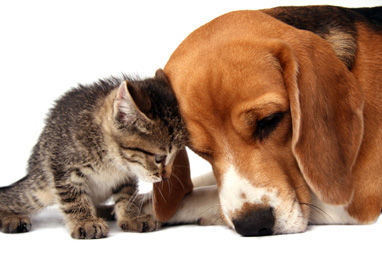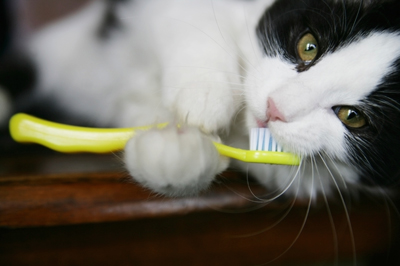May Newsletter
Heads Against the Wall: It May Look Silly, But It Could Indicate A Problem
It’s known as “pressing;” the strange, yet unquestionably cute behavior of dogs or cats standing with their heads planted face-first against a wall or other object for no apparent reason. Are they putting themselves in timeout? Are they ashamed of something they’ve done? This behavior could indicate a medical problem and should be checked by your veterinarian.
What It May Mean
Head pressing is typically indicative of damage to the pet’s nervous system. What can cause this damage? There are several possibilities.
In addition to poisoning, pressing behavior can also be a symptom of a brain tumor, head trauma, liver shunt, metabolic disorder, infection of the brain or spinal cord, or stroke.
It could also be an indicator of prosencephalon disease. More commonly referred to as the forebrain, the prosencephalon is the forward-most portion of the brain. With this disease, the forebrain and thalamus become damaged and pets may exhibit circling, changes in learned behavior, damaged reflexes, pacing, pressing, seizures and/or vision problems. Dogs and cats of any age or breed can be affected.

What To Do
A visit to your veterinarian will help get to the bottom of the behavior. Providing your veterinarian with a thorough history of your dog or cat's health, when the head pressing first began and possible incidents that might have preceded it, will help him or her in diagnosing the cause.
Diagnostic tests, such as blood and urine testing, X-rays and a complete physical examination, may determine the cause of the head pressing. Advanced tests, such as MRI or CT scan, may be required if the initial results come back negative.
Not To Be Confused With Normal Behavior
It’s normal for healthy pets to rub or butt their heads against objects, animals and people. Known as bunting, this is a form of territorial scent-marking. Pressing, on the other hand, indicates a serious medical condition and is abnormal.
By itself, head pressing may not be dangerous to your pet - the concern lies in what it could be signaling. You know your pet better than anyone. If something seems off, call your veterinarian as soon as possible.
Health Benefits of Pet Ownership for the Elderly
The link between good health and having pets in the home has been well established by multiple studies and is noted on the U.S. Centers for Disease Control (CDC) website, among other places. Additionally, these health benefits are not just limited to families with children.
The CDC and numerous studies conducted by a wide range of organizations have shown multiple physical and mental health benefits for the elderly who keep companion pets. For example, PAWSitive Interaction, a nonprofit group dedicated to better understanding the positive impact of the human/animal bond, produced a white paper titled Pets and The Aging: Science Supports the Human/Animal Bond. The paper brings together experts in this field as well as scientific research to more fully explain the benefits to the elderly of pet ownership.

Health benefits include:
• Lower Blood Pressure – Studies have shown that when pet ownership is combined with medication, blood pressure is more easily controlled than in populations that use medication alone.
• Reduced Depression – Simply spending time with a pet dramatically increased production of hormones in the body that regulate well-being and happiness. Production of hormones that are related to stress and anxiety decreased as dramatically.
• Decreased Loneliness – It is common for the elderly to be and feel isolated from the rest of the world. However, having a pet and taking care of it provide reasons for a person to become more engaged with life. They get out for walks more and come into contact with a wider range of people. This in turn acts as a social catalyst between peers and others. A pet also is a companion and provides a sense of responsibility and well-being.
• Increased Heart Attack Survival – One study showed that heart attack survivors who have a pet are four times more likely to live another year or longer.
• Improved Alzheimer's – A Purdue University study found that the presence of aquarium fish has a calming effect and increased appetites at meal time.
Other studies have shown:
Improved Personal Care – Pets act as something of a personal alarm clock to remind the person to care for him or herself in terms of hygiene as well as reminders when to eat (e.g. feed the pet at the same time as dinner).
Regular Exercise – Taking care of a pet, especially a dog that needs to be walked or an animal that responds to play can help seniors get out for regular exercise through walking. This also provides an opportunity to interact with other pet owners as well as neighbors and friends.
Touch – People respond positively to and need regular touch. A pet such as a cat curled up in a lap or dog lying nearby can be very reassuring and relaxing to an older person as well as provide a sense of security.
We could go on, but the bottom line is that a companion pet—whether a bird, cat, dog and so on—can be as much a source of good health and vitality for the elderly as it would provide love and companionship.
Home Dental Care For Your Pet
In order for any dental program to work properly, home care follow-up is essential. Brushing your pet's teeth is the single most important procedure you can do to maintain good oral health. If performed regularly, daily brushing will dramatically increase the interval between teeth cleaning appointments.
Plaque is constantly being made and deposited in the mouth. Humans have a buildup of plaque in the morning. This accumulation of plaque makes our breath smell bad. Proper dental care, for dogs as well as humans, can keep plaque buildup under control. People brush their teeth several times daily to remove plaque — why not our pets? The goal of dental home care is to remove plaque from tooth surfaces and under the gum line before it mineralizes into calculus, a process that occurs within days of a teeth cleaning. Success depends on the owner's ability to brush the pet's teeth, as well as the dog or cat's acceptance of the process. True oral cleanliness can only be achieved through the mechanical action of toothbrush bristles above and below the gum line.
Home care is best started at a young age, before the adult teeth erupt. The younger the animal is, the more likely he or she is to accept it. Your veterinarian may discuss the advantages of home dental care at the time of your pet's first vaccinations. Daily brushing not only keeps your pet's teeth clean and healthy, it also enhances the bond between you and your pet.

A misconception is that hard food keeps pets' teeth clean. Some believe that when their dog or cat chews on hard food or biscuits, mineral deposits are broken down and the teeth stay clean. This is not true. Granted, animals on soft diets accumulate plaque more readily than those on dry foods, but the only way to keep teeth clean above and below the gum line is by daily brushing.
If you are unsure of how to brush your pet's teeth, you may want to ask a veterinary hospital staff member for instructions or watch this video by the American Veterinary Medical Association. Proper brushing technique involves applying the bristles at a 45-degree angle to the gums. Use small circular motions around the outside of the teeth, being sure to get the bristles under the gum line. It is not as important to brush the inside of the teeth, as dogs and cats do not accumulate as much tartar on the insides of their teeth.
The most important area to keep plaque and tartar from accumulating is under the gum line. Adding products such as Oxyfresh to the drinking water or rubbing the teeth with dentifrice impregnated pads may help in home care, but it's necessary to understand that periodontal disease begins below the free margin of the gum line.
Getting Your Pet to Accept Tooth Brushing
• Start with a healthy comfortable mouth - Untreated problems can cause pain and a non-compliant patient. Dental pathology must be cared for first. If you suspect that your pet has an accumulation of tartar, a painful mouth (he pulls away each time you touch his head or jaw), bad breath, or a problem chewing, drinking or swallowing, a veterinary dental exam is in order.
• Choose a proper toothbrush and toothpaste - Toothbrushes have bristles that reach under the gum line and clean the space that surrounds each tooth. Plaque accumulates in this space. Devices such as gauze pads, sponge swabs, or cotton swabs remove plaque above the gum line, but cannot adequately clean the space below the gum line.
• The size of the toothbrush you choose is important - There are specific brushes for mouths of long muzzled dogs, as well as small brushes for cats. Each dog or cat must have his or her own toothbrush. Sharing brushes may result in cross contamination of bacteria from one pet to another.
• Introduce the toothpaste and toothbrush gradually - When you sense that your pet has had enough, give him reassurance by talking and try again. Expect progress not perfection. Reward progress immediately with a treat or a play period after each cleaning session. Don't expect to brush your pet's teeth on the first try. Take time. Each pet is different. Some will be trained in one week, while others will take a month or more. The payoff is well worth the learning curve.
The type of dental home care products dispensed by your veterinarian may vary from animal to animal. Trust your veterinarian to dispense the products that are best suited to your own pet's dental needs.





